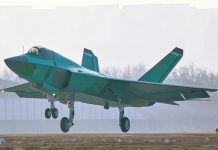The satellite image shows a new hangar housing UAVs, J-20, J-11 fighter jets and AEW&C aircraft.
A satellite image released on February 1 shows the latest upgrades at Hotan airbase in China’s Xinjiang province near the Ladakh border where the Chinese PLA is currently locked in a stand-off with the Indian Army.
The satellite image released by open-source intelligence Twitter handle @detresfa_ shows a new hangar housing unmanned aerial vehicles and J-20s.
The image also reveals a taxiway and munitions bunkers — both under construction — with markings for one more possible unit. A ‘cut-and-cover tunnel’ was also spotted at the site.
In addition, the image shows a J-11 preparing for take-off. The airbase hosts various other platforms such as J-20, UAVs, airborne early warning and control (AEW&C) aircraft, and electronic warfare systems.
As per the geospatial intelligence (GEOINT) analysis, the new infrastructure upgrades are aimed at boosting the military capabilities of the site amid the tensions with India. The Hotan airbase operates under the PLA Western Theater Command.
Pivotal in supporting #China's airforce operations near #Ladakh the Hotan airbase has been undergoing infrastructural improvements aimed at boosting operational capability, summarized in this report are some of the changes seen in the last few months #TheIntelLab pic.twitter.com/5iUUlBIvN8
— d-atis☠️ (@detresfa_) February 1, 2021
As per the analysis, “the new runway works along with munitions storage and auxiliary support facilities would help increase sortie rates, reduce any congestion, incase new units are assigned and allow for quicker turnaround time for any detachments operating during conflict operations”.
Earlier, satellite images had detected activity at Hotan Airbase was in October 2020. At the time, the images had revealed that the Chinese People’s Liberation Army Air Force (PLAAF) had deployed its Rainbow UAVs.
According to the assessment published by Air University’s China Aerospace Studies Institute (CASI), 12 unidentified variants of Flanker (Su-27) were stationed at the Hotan base from June 2020. China has deployed 24 aircraft including 6 J-8s, 12 Flanker variants (likely J-16s), two Y-8 electronic warfare aircraft, two KJ-500 early warning, and control aircraft, and two Mi-17 helicopters.
Meanwhile, China has also ramped-up upgrading the Ngari Gunsa airbase in Tibet, which is only 200 km from Pangong Lake, and at the Lhasa Gonggar Airport, a PLAAF base located close to Bhutan’s Doklam region, the site of the June 2017 standoff.
The satellite images have earlier revealed that the Chinese have upgraded the apron and built new hardened aircraft shelters, which will allow the PLAAF to accommodate more fighter jets at the airbase than before.
In Lhasa, Gonggar, and Shannan area of Tibet, new surface-to-air missile sites have come up, renovation and upgrades of airports, railway, and motorways have taken place from 2017 to 2020. This has improved the overall logistics and ensuring all-time support to the military despite the difficult terrains.
Given the tensions between #India & #China over the last three years in the eastern section of the Indo-Sino Border, here is a report that attempts to cover the increase of military infrastructure observed in strategic parts of #Tibet undertaken through 2017-2020 pic.twitter.com/oODDSI3rhn
— d-atis☠️ (@detresfa_) January 30, 2021
Meanwhile, India has also ramped up the infrastructure development with new roads along the loosely demarcated border to ensure smooth support to the troops serving in the forward posts. Along with its newly-inducted Rafale fighter jets, India has deployed MiG-29s, Su-30 MKIs, and Mirage 2000s in the Ladakh region.
Follow EurAsian Times on Google




